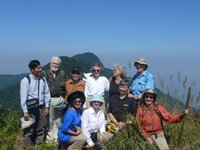 Part of the daily routine of butterfly watching for this project is logging each sighting on a data sheet. This sheet lists all the species that have been seen on a particular transect in the past - and there are also blanks for ones that we need to add, which we do from time to time. We have had to write in several new species for a transect.
Part of the daily routine of butterfly watching for this project is logging each sighting on a data sheet. This sheet lists all the species that have been seen on a particular transect in the past - and there are also blanks for ones that we need to add, which we do from time to time. We have had to write in several new species for a transect.
Today we walked transect 4. It had nine sections. For the entire transect we saw a total of 39 species and 189 individual butterflies.
 Sometimes we need to look in our butterfly guide to determine the species - we are not using common names of butterflies - but Latin. Viet and Lien both know most of them but sometimes even they have to look.
Sometimes we need to look in our butterfly guide to determine the species - we are not using common names of butterflies - but Latin. Viet and Lien both know most of them but sometimes even they have to look.
 When we begin a transect (a trail, defined by our research scientist) we first must log our name, the time, the temperature and humidity - both of which are read using a digital meter.
When we begin a transect (a trail, defined by our research scientist) we first must log our name, the time, the temperature and humidity - both of which are read using a digital meter.
 We pass a lot of the same village homes every day - and many of the people are curious. This day we stopped and said hello - and were greeted warmly. This lady is farming chayote (Sechium edule) - the most popular crop in this area because of the price it brings. Notice how the home is built on bamboo stilts in the back. Much of her crop is along some of the villa ruins I spoke of earlier. All the planting is done by hand - and with the use of simple bamboo shovels. Water is carried on bamboo rods and poured with a dipper.
We pass a lot of the same village homes every day - and many of the people are curious. This day we stopped and said hello - and were greeted warmly. This lady is farming chayote (Sechium edule) - the most popular crop in this area because of the price it brings. Notice how the home is built on bamboo stilts in the back. Much of her crop is along some of the villa ruins I spoke of earlier. All the planting is done by hand - and with the use of simple bamboo shovels. Water is carried on bamboo rods and poured with a dipper. We were served tea and then asked if we could take a photo of our hostess. At first she whined and said no, then agreed when we said we would be in it with her. This woman is 50 years old. The hard work she does and exposure to the sun makes her look a bit older.
We were served tea and then asked if we could take a photo of our hostess. At first she whined and said no, then agreed when we said we would be in it with her. This woman is 50 years old. The hard work she does and exposure to the sun makes her look a bit older.
































